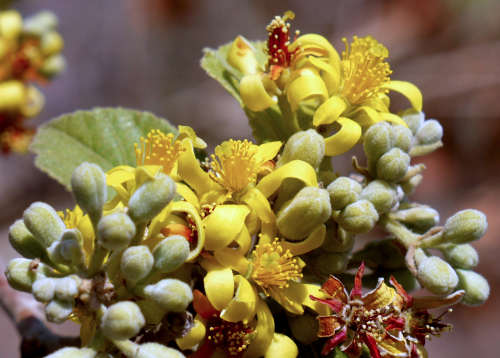Growing Sherbet Berry:
Grewia asiatica
Back to Fruit, Berries and Nuts
Botanical Overview
A member of the Mallow family (Malvaceae), the Grewia genus has well over one hundred species. Grewia asiatica is the most widely cultivated of those considered edible.
Description
Form:
Shrub or small tree.
Lifespan:
Perennial.
Leaf retention:
Deciduous.
Growth rate:
Rapid.
Mature Size:
6-22' (1.8-6.7m) high, depending on cultivar.
Flowers:
Small, five yellow petals and sepals, many yellow to orange stamens, clustered.
Bloom:
Late winter to early spring.
Self-pollinating:
Yes. Additional plants will improve fruit set.
Years before fruiting:
1.
Fruit:
Dark purple when ripe, 3/8-3/4" (1-1.9cm) diameter, apple texture, sweet-sour grape-sherbet flavor,
1-2 seeds. Nutritional values for 3.5 oz (99 gm): Vitamin A 37%, Vitamin C 24%, Calcium 13%.
Months for fruit to ripen:
3. The fruit are ripe when they are dark purple, possibly with a whitish blush, and are
soft. They ripen a few at a time and require frequent harvesting. A well-managed plant can
produce 15 lb (6.8 kg) of fruit in one year.
Storage after harvest:
The fruit can be refrigerated unwashed for 3-7 days. They are very perishable and transport
poorly.
Leaves:
Large, ovate to heart-shaped, dull gray-green, toothed margins, prominent veins.
Stems:
Long, drooping, no thorns.
Roots:
Densely fibrous, no tap root, not invasive.
Cultivars of Note:
The low growing dwarf types native to India are cultivated because of their flavor, small seeds, and productivity. The taller wild varieties are not considered good tasting.
The low growing dwarf types native to India are cultivated because of their flavor, small seeds, and productivity. The taller wild varieties are not considered good tasting.
Wildlife:
The flowers attract a wide variety of pollinating insects, including bees and butterflies.
The leaves and fruit are browsed by mammals.
Toxic / Danger:
No.
Origin:
Southern Asia, from Pakistan to Cambodia.
Cultivation and Uses
USDA hardiness zones:
9b-11. Young plants need protection below 32°F (0°C). Older plants may be hardy to
20°F (-6.7°C).
Chill hours:
None.
Heat tolerant:
Yes.
Drought tolerant:
Yes, but less so at higher temperatures.
Sun:
Full sun to light shade.
Planting:
Locate these plants in full sun in well draining soil. Place 6' (1.8m) apart when grown for
fruit harvesting and given a severe winter pruning.
They can be grown in large containers and moved indoors in winter.
Soil:
Well draining, moderate to high organic content, pH 6.1-6.5 (mildly acidic). This plant is salt
sensitive.
Fertilize:
Use an organic fertilizer every other month. Avoid chemical fertilizers.
Water after becoming established:
Deep water weekly when fruiting. The soil must be
dry 2" (5cm) deep before watering again. Do not over-water.
Containers need more frequent irrigation.
Mulch:
Spread organic mulch over the root area, and 8" (21cm) away from the trunk, to provide
moisture retention and reduce heat stress.
First Year Care:
Protect from freezing.
Prune:
Severe early-winter pruning to a 3-4' (1-1.2m) height improves productivity.
Flowers appear on new growth.
Litter:
Leaf drop in late fall to early winter.
Propagation:
Hardwood cuttings, treated with IBA 2000 ppm concentration solution, and planted in July in
a humid mist chamber, root quickly.
Seed usually germinate in 15-20 days when fresh and tends to be true to parent.
Dried seed is not viable after 90 days.
Uses:
Edible fruit. The leaves are used as an animal fodder. The flexible wood has many uses.
The bark is used for soap and the bark fiber for making rope.
Comments
Another name for this plant is Phalsa or Falsa.
This fruit is widely grown in Asia and sold in farmer's markets and by street vendors.
Do you have additional information or a different experience for these plants that you would like to share? Email info@GardenOracle.com. All contributions are welcome and appreciated.
Do you have additional information or a different experience for these plants that you would like to share? Email info@GardenOracle.com. All contributions are welcome and appreciated.


Latest update: August, 2024
© 2008-2025 by GardenOracle.com

